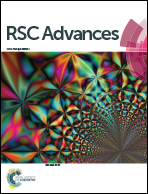A potentiometric biosensing system based on an isolated degrading bacterium Klebsiella sp. MP-6 for the determination of methyl parathion†
Abstract
A potentiometric sensing system for the sensitive and selective detection of methyl parathion (MP) is described in this paper. The system is based on a degrading bacterium Klebsiella sp. MP-6 as recognition element and a polymeric membrane anion-sensitive electrode as a transducer. Klebsiella sp. MP-6 can be isolated from long-term organophosphorus pesticide contaminated soils, which is capable of biodegrading MP to produce p-nitrophenol. The product can be deprotonated under basic conditions and thus detected by using the anion exchanger based membrane electrode. The bioreactor is prepared by packing the bacterial cells between two polyether sulfone membranes placed in a holder. Molecularly imprinted solid-phase extraction using the MP imprinted polymer as a sorbent enables accumulation and separation of MP from real samples. Under the optimized experimental conditions, the potential response of the biosensing system is linear with the MP concentration in the range of 5–100 nM. The detection limit is 1 nM. The electrode exhibits an excellent selectivity towards other organophosphorus pesticides. The sensing system has been evaluated with spiked water samples and shows good recovery and high accuracy. This methodology is promising to develop potentiometric sensors for detecting organophosphorus pesticides at trace levels in the environment.


 Please wait while we load your content...
Please wait while we load your content...